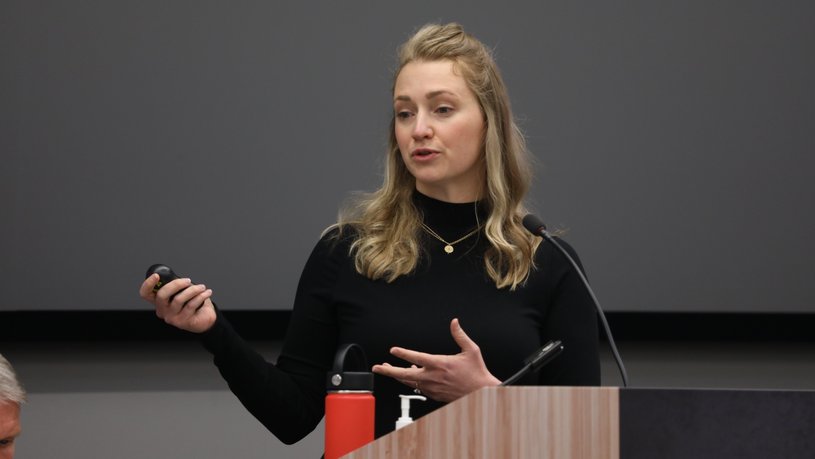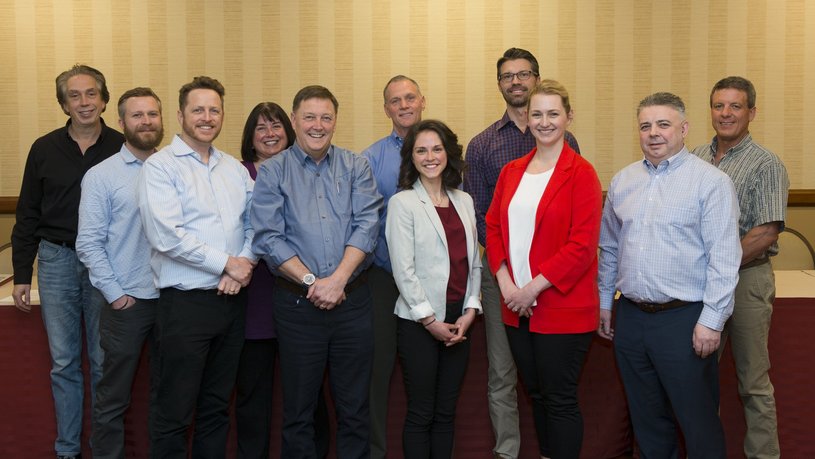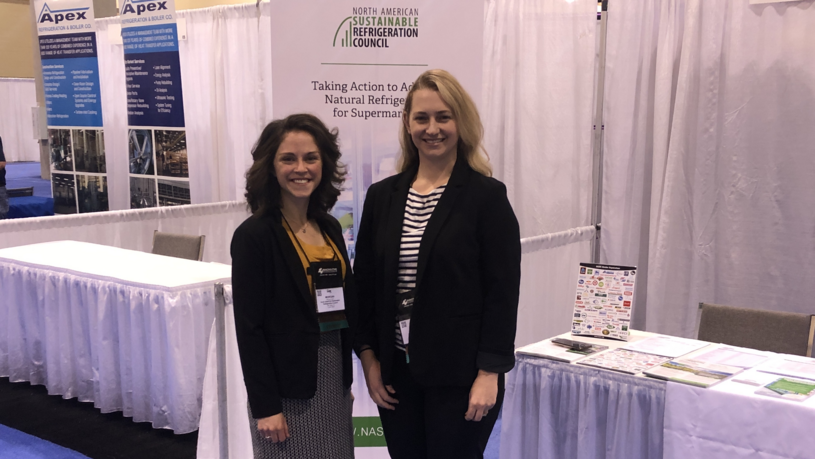As the NASRC Executive Director, Danielle Wright drives the adoption of natural refrigerants in North American supermarkets. We spoke to her about her motivation, current politics in the US and why Europe is a role model when it comes to HFC-free refrigeration.
Danielle has worked in the energy efficiency and sustainability field for more than ten years. Since 2017, she has been part of NASRC (North American Sustainable Refrigeration Council), an action-oriented environmental non-profit organization removing barriers for natural refrigerants in commercial refrigeration applications. Together with its network, the NASRC takes collective action to accelerate the adoption of climate-friendly refrigeration technologies. NASRC’s fields of work range from developing incentive funding, driving updates to codes and standards, increasing technician training and providing clarity & data to reduce uncertainty for supermarkets on the return on investment of different natural refrigerant technologies.
Prior to her role at NASRC, Danielle oversaw the EnergySmart Grocer program, a third-party energy efficiency program serving the grocery sector in the Pacific Gas & Electric (PG&E) territory. Under her management, the program saved over 100 million kWh from energy efficiency retrofits primarily in refrigeration.
Danielle, you studied International Relations. Today, you’re the Executive Director of NASRC. How did you get into the refrigeration sector professionally?
I loved studying International Relations. It was fascinating to learn how policy could drastically impact economic and human health. At the time, I secretly hoped it might bring me back to France where I grew up.
My last semester in school I took a class on sustainable living that shifted my focus completely. I became passionate about the built environment; particularly how energy efficiency opportunities could translate to both environmental wins and business wins. Supermarkets are a perfect example because of their high energy-use intensity and low-margins. Every dollar saved on energy costs contributes exponentially to the bottom line.

I managed a utility sponsored program to optimize the energy efficiency of supermarket refrigeration systems for a number of years before I learned about refrigerants and their impact on global warming. I believed very strongly in the mission of NASRC, and even volunteered, before joining the organization as the executive director. It truly is my dream job.
Why do you personally care about the environment?
The environment is essential to human existence! Without the environment, there is nothing. The air we breathe, the water and food we take in, everything about our quality of life depends on the health of our environment. I don’t want to have to look my daughters in the eye and explain why we didn’t do more to preserve it for them.
You mention that we should preserve the environment to the benefit of future generations. How do you envision the ideal cooling sector of the future?
Ideally, I want to work myself out of the job. My goal is for sustainable cooling to be the only type of cooling. There shouldn’t be a trade-off between what is good for the environment and what is good for business.

At the end of January, US President Joe Biden has issued an executive order seeking the US Senate’s consent to ratify the Kigali Amendment to phase down HFC refrigerants. What was your first thought when you heard that?
President Biden made a number of climate commitments, including supporting ratification of Kigali, as part of his campaign platform. So, this executive order was not a surprise. In fact, the mechanics of the Kigali Amendment were approved under the previous Administration in December 2020 through the American Innovation in Manufacturing (AIM) Act. The AIM Act received bipartisan and widespread support, including from both manufacturing and environmental groups. It mirrors the Kigali Amendment phasedown schedule and authorized the US Environmental Protection Agency to regulate HFCs.
My concern is that the Kigali Amendment won’t go far enough, fast enough to make an impact. There is a possibility that the allocation schedule will drive only a transition from HFCs, with high global warming potential (GWP), to HFO-blends with medium-GWP level, instead of to zero or near-zero GWP natural refrigerants. Not only will this represent a big missed opportunity in terms of GHG reduction, it will put US businesses at risk of having to navigate multiple refrigerant transitions when more stringent regulations come out in the future.
US businesses are already at a disadvantage. The latest innovations in the global refrigeration space use natural refrigerants. Yet many of these technologies aren’t even available in the US. For example, we just released a report highlighting the large demand and opportunity for natural refrigerant condensing units. The US needs to set more aggressive HFC-reduction targets, beyond the Kigali Amendment, in order to spur availability of natural refrigerant technologies and remain competitive in the global market.
Do you think that this step could also be a signal for other countries like India or China (which have not yet ratified the Kigali Amendment) to take action?
Yes, this step is widely regarded as a signalling mechanism to the rest of the world because the Kigali phase-down schedule was already signed into law through the AIM Act. I think it’s a matter of when, not if, they take action since the “non-Parties” will be banned from trading with ratified parties beginning in 2033.

In your TEDx Talk on sustainable cooling, you refer to the EU's F-Gas Regulation as a great example of how effective policy can accelerate change. Why is the Directive a success in your eyes?
The biggest success metric is the adoption rate of HFC-free systems in Europe. There is an order of magnitude difference compared to the US. One example is the number of CO2 transcritical systems installed in the past two years. Since 2018, the US had only 300 installations (650 total) while Europe has over 4 times that many with 13,000 installations (29,000 total). Less than 2% of US supermarkets have HFC-free refrigeration systems, which represents a tremendous opportunity for natural refrigerants.
Europe is not plagued with the same issues we see here in the US such as high costs, energy penalties, and lack of trained workforce. The aggressive F-gas Regulation, coupled with individual countries’ financial incentives, stimulated rapid adoption that enabled natural refrigerant technologies to reach economies of scale. It’s now more cost-effective for a food retailer to install natural refrigerant-based equipment rather than a half-way solution like R-448a/R-449a. Effective regulations give both manufacturers and retailers the certainty they need to move forward quickly.
This video is being blocked because of your cookie settings.
In the US, the lack of regulatory certainty has created a negative reinforcing cycle that keeps demand low. It starts with high-cost premiums for natural refrigerant technologies, which are between 20% to 200% higher than traditional HFC systems. This drives low adoption rates, lack of performance data, and a service workforce that is unprepared and untrained in natural refrigerants. Since manufacturers aren’t able to generate the volume of demand to achieve economies of scale, costs remain high and continues to perpetuate low demand.
To bridge the gap, we’ve been working to drive funding opportunities in California, where there are more stringent regulations. But stronger federal leadership is needed through funding mechanisms like tax credits or accelerated depreciation to drive demand and drive economies of scale. This is why I say I am concerned that the Kigali Amendment will not get us there fast enough. Effective policies coupled with financial incentives have the power to reverse this negative reinforcing cycle, remove barriers, and ultimately make natural refrigerants a good business choice.
Truth be told: Do you personally have a climate-friendly fridge or air conditioner at home?
My house does not have air-conditioning, the most climate-friendly option! I am actually holding out installing AC until we have natural refrigerant-based units available. The US only recently approved climate-friendly domestic fridges (see list here). My fridge at home is older but I will certainly take the steps to properly recycle and purchase a new climate-friendly fridge once it’s time to replace.
Please complete
The biggest obstacle for Green Cooling at the moment is…
"Higher first costs compared to HFC technologies."
There should be more women in refrigeration and air conditioning because…
"Every industry benefits from diversity."
I love my job because…
"Every day is an opportunity to make an impact."




